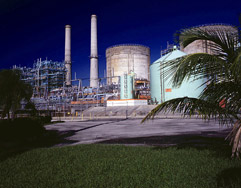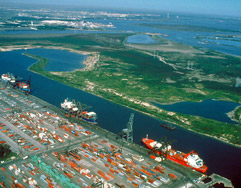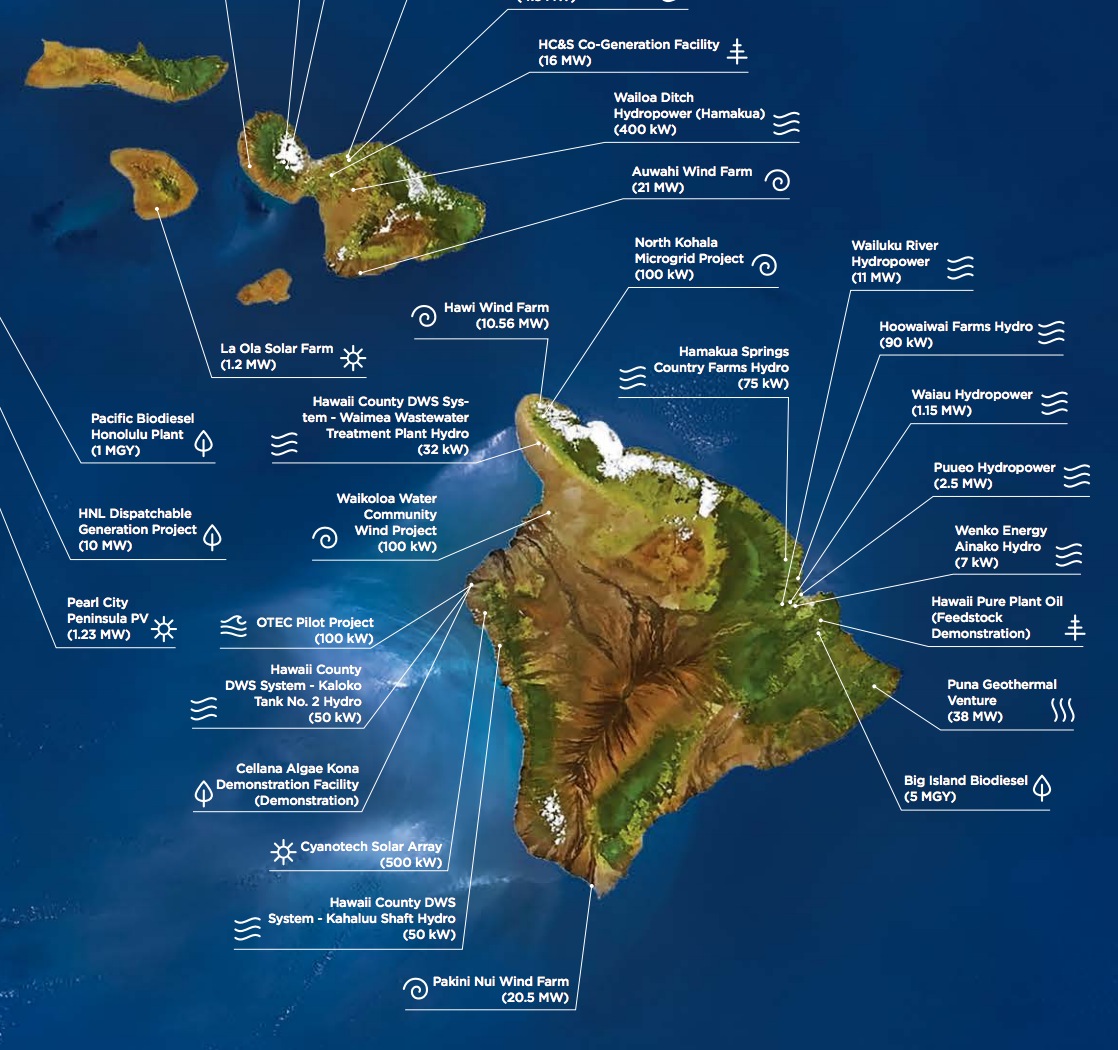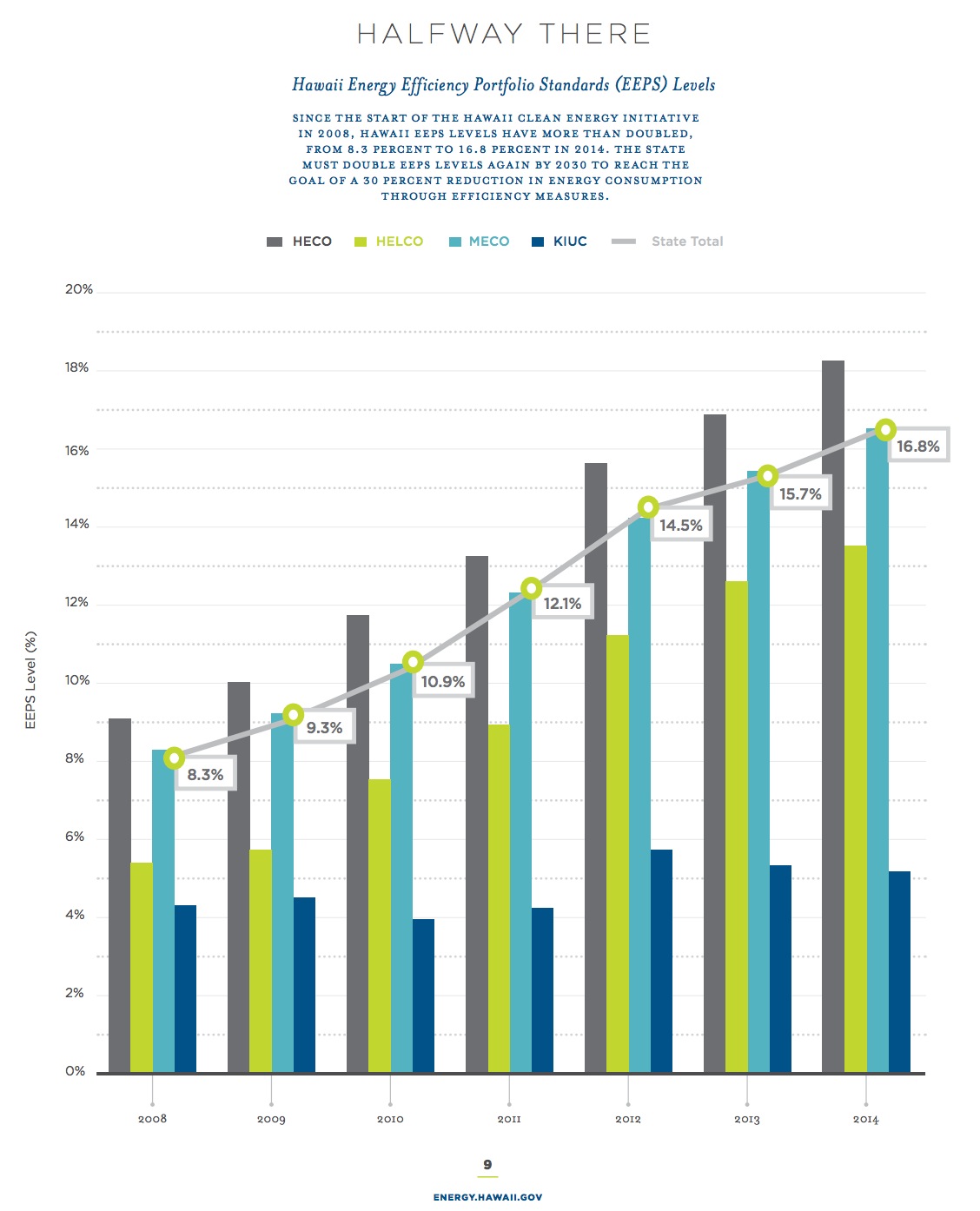HAWAII STATE ENERGY OFFICE
The past year marks a turning point in the history of energy in Hawaii. Since the establishment of the Hawaii Clean Energy Initiative in 2008, the state has been moving from fossil fuels to clean energy sources. Building on tremendous progress in recent years, in 2015 the state accelerated its commitment to an unprecedented level: 100 percent renewable energy in the electricity sector by 2045. This report details Hawaii’s efforts to increase energy efficiency, renewable energy, and the regulatory, technical and practical efforts required to make this world’s-first ambition possible.
Energy Efficiency – The most direct way to get all of the state’s energy from renewable sources is to use less energy. Energy Efficiency Portfolio Standards (EEPS) tracks the amount of energy use offset by efficiency savings, with a goal of cutting electricity use by 4,300 gigawatt-hours by 2030, which equates to a 30 percent reduction. By the end of 2014 the state had reduced electricity consumption by about 1,500 gigawatt-hours, or 16.8 percent.
There are many ways to achieve energy efficiency savings – which also have a sizable impact on carbon emissions – utilizing new and retrofit technologies in residential and commercial buildings. The challenge is often financing, where Hawaii has made progress using federal dollars to extend credit and expanding energy performance contracting, which uses future energy savings to pay for efficiency upgrades. Other advances include progress at state agencies, businesses and in building codes to embrace greater energy efficiency.
Renewable Energy – An independent energy future is one powered by renewable sources of energy, all of which are present in Hawaii at the highest grade. Having met the previous milestone years ahead of schedule, Hawaii reset its Renewable Portfolio Standards (RPS) in 2015 to 100 percent by 2045. The state is just past one fifth of the way there based on the current RPS formula.
The challenge in reaching the 100 percent RPS is not only innovating ways to tap into Hawaii’s plentiful natural, clean sources of power, but building the grids and interconnection infrastructure to make them accessible and affordable. Hawaii has become the world’s foremost test bed for renewable energy advancements to figure this out.
Transportation and Planning – To guide the way forward, planning for implementation, energy assurance and integrating new energy sources and loads will be paramount. The area of greatest focus will be modeling the increasingly integrated energy eco-system where electric sector and electrification of the transportation sector create greater interdependencies and opportunities. Accordingly, HSEO is developing a model to capture the interdependencies of Hawaii’s energy eco-system. To support energy independence in the transportation sector and enhance the analytics relative to the energy eco-system HSEO commissioned a Transportation Energy Analysis to identify tactics and enabling actions that reduce petroleum consumption in the transportation sector. Similar plans to boost the accessibility of community-based renewables, including distributed solar power and microgrid projects, are advancing apace.
Clean, Renewable Energy Policy – To encourage entrepreneurship and innovation and make progress towards energy independence in Hawaii, the proper regulatory framework must be in place. The state’s ambitious 100 percent renewable goal is itself a statute that has catalyzed broad advancement at all levels. Subsequent policies and initiatives are spurring utilities to remove obstacles to progress, requiring public institutions like the University of Hawaii to transform their energy use, fostering innovation in distributed generation, hydrogen and other technologies, financing green energy upgrades and aligning efforts to reduce greenhouse gas emissions with renewable energy goals – all while ensuring responsible stewardship of the environment.
Deployment and Innovation – Even as the groundwork is laid, efforts to build and deploy tomorrow’s clean energy systems must already be in development. The state is working with partners in Hawaii and globally to gather expertise and finance, test, implement and refine programs that will advance the state’s clean energy vision.
As the state continues to realize that vision, this report will track its progress on the way to energy independence. Serving as the Energy Resources Coordinator (ERC), the Director of the Department of Business, Economic Development, and Tourism (DBEDT) is responsible for planning, managing and monitoring Hawaii’s energy program as mandated by the Hawaii Revised Statutes (HRS 196-4). The report satisfies the requirements of Act 95 of 2004 which added HRS 196-41(c) requiring that DBEDT submit a progress report biannually, starting in January 2006, to the governor and legislature on its: (1) progress in the development of a program to maximize the use of renewable energy and cost-effective conservation measures by state government agencies; and (2) work with federal agencies to develop as much research, development and demonstration funding and technical assistance as possible to support Hawaii in its efforts to achieve its renewable portfolio standards.
Under the leadership of the ERC, the Hawaii State Energy Office (HSEO) works to implement the state’s clean energy vision to transform Hawaii’s economy by growing the clean energy sector. To this end, HSEO deploys clean energy infrastructure as a catalyst for economic growth, energy innovation and test bed investments. HSEO aims to align its policies among government agencies and the private sector. It provides the framework and tools for energy developers and investors to pursue opportunities that further Hawaii’s clean energy economy.
Download full version (PDF): State of Hawaii Energy Resources Coordinator’s Annual Report 2015
About the Hawaii State Energy Office
energy.hawaii.gov
The Hawaii State Energy Office is leading the state’s charge toward clean energy independence. With a goal to achieve 100 percent renewable energy generation by 2045, the Hawaii State Energy Office is committed to developing and deploying high impact solutions that will maximize Hawaii’s renewable energy resources and improve efficiency and transportation standards. Through effective policies and innovative programs, the Hawaii State Energy Office has positioned Hawaii as a proving ground for clean energy innovation, which will generate quality jobs, attract investment opportunities and accelerate economic growth. The Hawaii State Energy Office is a division of the state’s Department of Business, Economic Development and Tourism.
Tags: Energy Resources Coordinator, ERC, Hawaii, Hawaii State Energy Office, HI, HSEO








 RSS Feed
RSS Feed